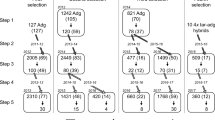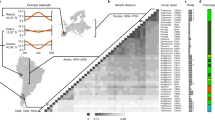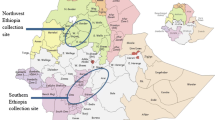Abstract
The modern cultivated potato was first recorded in Europe in 1562, but its area(s) of exportation has long been in dispute. Two competing hypotheses have proposed an “Andean” area (somewhere from upland Venezuela to northern Argentina) or a lowland south central “Chilean” area. Potato landraces from these two areas can be distinguished, although sometimes with difficulty, by (1) cytoplasmic sterility factors, (2) morphological traits, (3) daylength adaptation, (4) microsatellite markers, and (5) co-evolved chloroplast (cp) and mitochondria (mt) DNA. The Chilean introduction hypothesis originally was proposed because of similarities among Chilean landraces and modern “European” cultivars with respect to traits 2 and 3. Alternatively, the Andean introduction hypothesis suggests that (1) traits 2 and 3 of European potato evolved rapidly, in parallel, from Andean landraces to a Chilean type through selection following import to Europe, and (2) the worldwide late blight epidemics beginning in 1845 in the United Kingdom displaced most existing European cultivars and the potato was subsequently improved by importations of Chilean landraces. We reassess these two competing hypotheses with nuclear microsatellite and cpDNA analyses of (1) 32 Indian cultivars, some of which are thought to preserve putatively remnant populations of Andean landraces, (2) 12 Andean landraces, and (3) five Chilean landraces. Our microsatellite results cluster all Indian cultivars, including putatively remnant Andean landrace populations, with the Chilean landraces, and none with the “old Andigenum” landraces. Some of these Indian landraces, however, lack the cpDNA typical of Chilean landraces and advanced cultivars, indicating they likely are hybrids of Andean landraces with Chilean clones or more advanced cultivars. These results lead us to reexamine the hypothesis that early introductions of potato to Europe were solely from the Andes.

Similar content being viewed by others
References
Butler EJ (1903) Potato diseases (Solanum tuberosum) of India. Agric Ledger 10:87–124
Casañas R, González M, Rodríguez E, Marrero A, Díaz C (2002) Chemometric studies of chemical compounds in five cultivars of potatoes from Tenerife. J Agric Food Chem 50:2076–2082
Dastur JF (1917) Conditions influencing the distribution of potato blight in India. Agric J India 12:90–96
Dutt BL (1979) Bacterial and fungal diseases of potato. Indian Council of Agricultural Research, ICAR), New Delhi
Ghislain M, Spooner DM, Rodríguez F, Villamón F, Nuñez J, Vásquez C, Waugh R, Bonierbale M (2004) Selection of highly informative and user-friendly microsatellites (SSRs) for cultivated potato genotyping. Theor Appl Genet 108:881–890
Gil González J (1997) El cultivo tradicional de la papa en la isla de la Tenerife. Associación Granate, La Laguna
Glendinning DR (1975) Neo-Tuberosum: new potato breeding material 2. A comparison of Neo-tuberosum with selected Andigena and with Tuberosum. Potato Res 18:343–350
Glendinning DR (1983) Potato introductions and breeding up to the early 20th century. New Phytol 94:479–505
Grun P (1990) The evolution of cultivated potatoes. Econ Bot 44[Suppl 3]:39–55
Hamester W, Hils U (2003) World catalogue of potato varieties. Agrimedia, Bergen/Dumme
Hawkes JG (1990) The potato: evolution, biodiversity, and genetic resources. Belhaven Press, London
Hawkes JG, Francisco-Ortega J (1992) The potato in Spain during the late 16th century. Econ Bot 46:86–97
Hawkes JG, Francisco-Ortega J (1993) The early history of the potato in Europe. Euphytica 70:1–7
Hosaka K (1993) Similar introduction and incorporation of potato chloroplast DNA into Japan and Europe. Jpn J Genet 68:55–61
Hosaka K (1995) Successive domestication and evolution of the Andean potatoes as revealed by chloroplast DNA restriction endonuclease analysis. Theor Appl Genet 90:356–363
Hosaka K (2003) T-type chloroplast DNA in Solanum tuberosum L. ssp. tuberosum was conferred from some populations of S tarijense Hawkes. Am J Potato Res 80:21–32
Hosaka K, Hanneman Jr RE (1988) The origin of the cultivated tetraploid potato based on chloroplast DNA. Theor Appl Genet 76:172–176
Huamán Z, Spooner DM (2002) Reclassification of landrace populations of cultivated potatoes (Solanum sect. Petota). Am J Bot 89:947–965
International Potato Center (1999) Molecular biology laboratory protocols: plant genotyping. In: Ghislain M, Zhang D, Herrera R (eds) Genetic Resources Department, training manual, CIP, Lima
Johnson, GW (1847) Gardener 1:19
Juzepczuk SW, Bukasov SM (1929) A contribution to the question of the origin of the potato (in Russian). Proc USSR Congr Genet Plant Anim Breed 3:592–611
Kawagoe Y, Kikuta Y (1991) Chloroplast DNA evolution in potato (Solanum tuberosum L.). Theor Appl Genet 81:13–20
Lössl A, Adler N, Horn R, Frei U, Wenzel G (1999) Chondriome-type characterization of potato: mt α, β, γ, δ, ε and novel plastid-mitochondrial configurations in somatic hybrids. Theor Appl Genet 98:1–10
Powell W, Baird E, Duncan N, Waugh R (1993) Chloroplast DNA variability in old and recently introduced potato cultivars. Ann Appl Bot 123:403–410
Provan J, Powell W, Dewar H, Bryan G, Machray CG, Waugh R (1999) An extreme cytoplasmic bottleneck in the modern European cultivated potato (Solanum tuberosum) is not reflected in decreased levels of nuclear diversity. Proc R Soc London Ser B 266:633–639
Raker C, Spooner DM (2002) The Chilean tetraploid cultivated potato, Solanum tuberosum, is distinct from the Andean populations; microsatellite data. Crop Sci 42:1451–1458
Salaman RN (1937) The potato in its early home and its early introduction into Europe. J R Hortic Soc 62:61–77, 112–123, 153–162, 253–266
Salaman RN (1949) The history and social influence of the potato. Cambridge University Press, Cambridge
Salaman RN, Hawkes JG (1949) The character of the early European potato. Proc Linn Soc London 161:71–84
Simmonds NW (1966) Studies on the tetraploid potatoes II. Factors in the evolution of the Tuberosum Group. J Linn Soc Bot 59:43–56
Spooner DM, Hetterscheid WLA (2005) Origins, evolution, and Group classification of cultivated potatoes. In: Motley TJ, Aorega N, Cross H (eds) Darwin’s harvest: new approaches to the origins, evolution, and conservation of crops. Columbia University Press, New York (in press)
Swaminathan MS (1958) The origin of the early European potato-evidence from Indian varieties. Indian J Genet Plant Breed 18:8–15
Terry E (1655) Voyage to East India. John Wilkie, London (reprinted in 1777 from the edition of 1655)
Vilaro FL, Plaisted RL, Hoopes RW (1989) Comparison of cytoplasmic male sterilities in progenies of Tuberosum × Andigena and Tuberosum × Neo-Tuberosum crosses. Am Potato J 66:13–24
White GF (1838) In: Roberts E (ed) Views in India, chiefly among the Himalayan Mountains. Fisher Sons and Co, London Paris
Acknowledgements
We thank S.K. Chakrabarty, Senior Scientist, Central Potato Research Institute, India for supplying DNA samples of the Indian collections.
Author information
Authors and Affiliations
Corresponding author
Additional information
Communicated by J.S. Heslop-Harrison
Rights and permissions
About this article
Cite this article
Spooner, D.M., Nuñez, J., Rodríguez, F. et al. Nuclear and chloroplast DNA reassessment of the origin of Indian potato varieties and its implications for the origin of the early European potato. Theor Appl Genet 110, 1020–1026 (2005). https://doi.org/10.1007/s00122-004-1917-0
Received:
Accepted:
Published:
Issue Date:
DOI: https://doi.org/10.1007/s00122-004-1917-0




